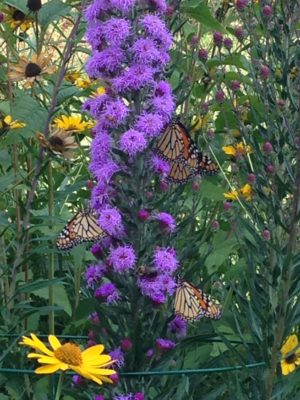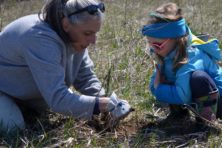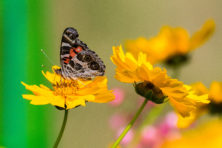Plant A Pollinator Garden
- Share
- Tweet
- Pin
- Share

by Don Gustafson
Insect pollinators, bees, wasps, butterflies, moths, beetles and flies are in trouble. Populations are disappearing at alarming rates due to pesticides, parasites, diseases, lack of crop diversity (mono crops such as corn, soybean and wheat fields), flowerless landscapes (lawn) and poor management practices. According to the Minnesota Department of Agriculture, we have fewer managed honeybee colonies today than at any time in the last 50 years in the U.S.
Seems like a big problem? It is! A decline in pollinators affects us all. More than one third of all plants or plant products consumed by humans are directly or indirectly dependent on insects for pollination. Many plants such as apple, blueberry, sunflower and clover cannot reproduce without the help from insect pollination.
Reversing this trend is important to the ecosystem as well as to human health and wellbeing. We can all do our part to help. Here is what you can do to help create a new habitat: help pollinators in your own backyard.
Here are some simple steps you can take in your yard to create habitat and help pollinators survive and thrive while keeping the aesthetic appeal of your yard.
- Choose plants pollinators love.
- Plant a variety of flowers of different colors and shapes that bloom at different times to provide continuous pollen and nectar sources.
- Whenever possible, choose native plants.
- Choose plants that will grow best in your site conditions; consider the soil type, light, planting space, etc.
- When using a pesticide, especially an insecticide, choose a product that won’t harm bees and still be effective. Apply when bees are not foraging. Follow the label exactly. The label is the law.
- Create partnerships and spread the word. Tell your neighbors why you are creating a pollinator friendly landscape and encourage them to join in. Post signs to tell others about your pollinator protection efforts. Share your story and pictures with community. Create partnerships with other entities that can support pollinator habitats; for example, public parks, golf courses, cemeteries, schools, etc.
I believe having a pollinator garden next to my apple and cherry orchard has attracted pollinators (butterflies, bees, moths) and increased fruit production, enhanced biodiversity and improved the aesthetic appeal of my landscape.





